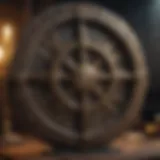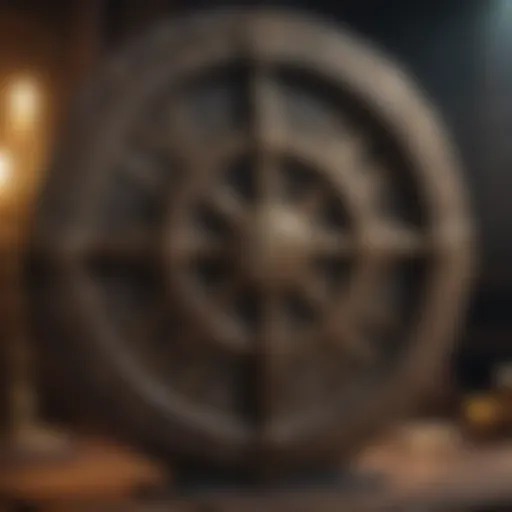Exploring the Connection Between Tarot and Luck
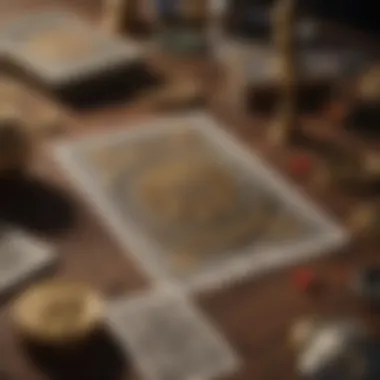

Intro
The universe is often thought to deal in mysteries, and for many, tarot cards represent a peek behind the veil. When it comes to luck, the tarot can transform one's approach to chance and fortune. It’s not merely about reading cards; it’s a blend of intuition, symbolism, and the inherent belief in luck that permeates life experiences. Although luck may seem random, tarot can provide a framework for navigating those unpredictable twists and turns.
As one explores the nuanced relationship between tarot and luck, they might begin to understand how specific cards—the so-called lucky tarot cards—can shape perceptions of fortune. Each card is imbued with layers of meaning, integrating not just personal beliefs but historical contexts as well.
For those who feel life has dealt them a tough hand, tarot can serve as a guiding light, fostering confidence by interpreting the signs of the universe. Let’s begin this journey into the hidden realms of luck and tarot, where every card has a story, and every reading can shift the tide of one’s fortune.
The Essence of Tarot
In the vast realm of divination and esoteric practices, tarot stands out as a powerful tool for introspection and guidance. This article seeks to illuminate the essence of tarot—an art form that combines artistry, symbolism, and deep psychological insights. Understanding the foundational principles of tarot is crucial for grasping its connection to the concept of luck, as these principles not only anchor its historical significance but also enhance its practical application in daily life.
Historical Background
Delving into the historical background of tarot reveals a fascinating lineage steeped in mystique and change. Originating in the 15th century, tarot's journey began as a simple deck of cards used for games in Italy. It wasn’t until the 18th century that tarot began to intertwine with mysticism and the occult, evolving from mere card play into a reputable source of divinatory wisdom. Figures such as Antoine Court de Gébelin and Éliphas Lévi played instrumental roles in shaping our modern perceptions of tarot by linking card imagery to ancient Egyptian mysteries and cabalistic traditions.
This historical evolution underscores the layers of meaning within the tarot, adapting through time and culture. It reflects societal beliefs, human psychology, and ancient wisdom, making each reading a timeless dialogue with oneself or the divine. The interplay of history and the mystical thus lays the groundwork for our understanding of how luck operates within tarot readings.
Understanding Tarot Decks
Not all tarot decks are crafted equally; they can vary significantly in imagery, theme, and purpose. Typically, a standard tarot deck consists of 78 cards, divided into the Major and Minor Arcana. However, delving deeper into the nuances of tarot decks reveals a rich tapestry of choices ranging from traditional decks Like the Rider-Waite-Smith to more niche variations influenced by specific cultures or philosophies, such as the Thoth Tarot or the Wild Unknown Tarot.
This diversity fosters a more personal connection. Choosing a deck that resonates with one's own intuition can enhance the reading experience, making it more relevant to the seeker’s own life circumstances. Deciphering the artistry and symbolism in these decks isn’t just a matter of aesthetics; it’s about understanding the language these cards speak to the soul, leading to enhanced clarity in matters of chance and fortune.
Major and Minor Arcana Explained
The tarot card system is primarily classified into two segments: the Major Arcana and Minor Arcana. The Major Arcana, comprising 22 cards, often symbolizes significant life themes. Cards such as The Wheel of Fortune and The Fool highlight transformative moments where luck plays a crucial role, marking pivotal changes or personal growth. For instance, The Wheel of Fortune embodies the cyclical nature of fortune, reminding readers that luck is ever-changing and often outside one’s control.
The Minor Arcana, on the other hand, consists of 56 cards, divided further into four suits: Cups, Pentacles, Swords, and Wands. These cards tend to represent everyday events and issues, from emotional aspects to practical concerns. Within these cards, readers can uncover subtle hints about their luck in day-to-day life. By examining the narratives held within both arcs, one gains a comprehensive view of how the universe balances fate, chance, and conscious choices.
"In the world of tarot, each card deeply whispers its secrets, waiting for the right moment to unfold to the right seeker."
Understanding the essence of tarot, its historical roots, decks, and the significance of each card lays the groundwork for exploring the intricate relationship between tarot and luck. This foundation not only enhances personal readings but also serves as a gateway to deeper insights into oneself and the forces that seem to shape one’s journey through the vicissitudes of life.
Concept of Luck in Tarot
The concept of luck in tarot serves as a pivotal axis around which many interpretations and practices revolve. It’s not merely about chance or random fortune; it's about a deeper, intuitive connection one can cultivate with the cards. This section aims to unpack the layers of what luck signifies within the tarot realm, how it varies culturally, and the ways tarot can act as a conduit for drawing in this elusive quality.
Defining Luck
Luck often gets tossed around like a hot potato, but its meaning is subjective. At its core, luck can be described as a favorable outcome in situations that are typically governed by chance. In the context of tarot, luck is more than just a stroke of good fortune; it embodies the alignment between intentions, spiritual insights, and conscious actions. When someone says they are "lucky" in tarot, it often conveys a sense of being in sync with the universe, where the cards reflect not only potential outcomes but the person's readiness to grasp opportunities.
Drawing cards with a mindset focused on luck can amplify this connection. It's about asking the cards to unveil what favors might be on the horizon. This definition closely ties into the spiritual dimension of tarot, where what might appear as luck is actually the manifestation of energies both within and outside oneself. An individual with a cohesive understanding of luck in tarot doesn't leave it all to chance; they interact empathetically with their environment to see potential pathways illuminated before them.
Cultural Perspectives on Luck
Luck is a multi-faceted gem, sparkling differently based on cultural context. In some cultures, such as in Chinese tradition, the number eight is associated with good fortune, prompting practices of feng shui that position individuals favorably within their spaces. In Western contexts, lucky charms, four-leaf clovers, and horseshoes hold significant meaning in navigating life's unpredictabilities.
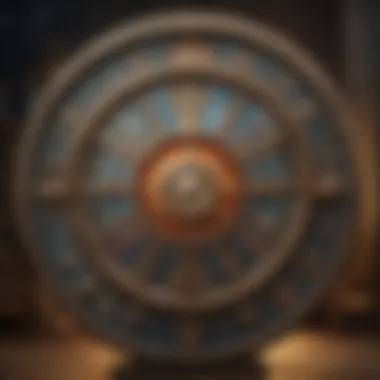

When it comes to tarot, various decks may not only house different archetypes but also reflect these cultural inclinations toward luck. The Leprechaun or the Goddess Fortuna could appear differently based on the allegiance of the tarot reader or the symbolism embedded within their culture. Each reading can reveal how these perspectives on luck are intricately woven together, showcasing a tapestry of beliefs that informs how people engage with tarot.
Tarot as a Tool for Attracting Luck
Tarot isn’t just about predicting a future that’s set in stone; it can actively assist individuals in forging their paths to fortune. It’s noteworthy that the way one approaches a tarot session can set the stage for luck to flow. Here are a couple of practical approaches:
- Intention Setting: Before even touching the cards, one ought to establish clear intentions. This clarity works almost like a magnet for favorable circumstances to come your way. Whether it's about love, career, or health, having a well-defined objective can heighten the likelihood of what is perceived as "luck."
- Visualization Techniques: Picture luck not as an inherent quality of the cards but as a result of your interaction with them. Engage in meditative practices before a reading to envision the outcomes you desire. Consider not just holding a lucky card, but embodying the image of abundance or success that particular card represents.
- Regular Practice: Just as athletes train to enhance their skills, tarot readers can engage in continuous practice to refine their intuitive abilities. The more familiar one becomes with the cards, the more adept they are at reading subtle energies and cues, creating conditions where luck feels almost inevitable.
In essence, luck through tarot transforms from mere happenstance into something actionable. Cultivating that relationship empowers practitioners; it makes them not only observers of fate but active players in the game of life.
Lucky Cards in Tarot
The exploration of lucky cards in tarot is an essential piece of the puzzle when examining the broader notion of luck within this mystic practice. Understanding lucky cards opens avenues for interpreting the deeper meanings behind specific cards and how they resonate with the energies of fortune in an individual's life. When practitioners seek guidance from tarot, the notion of luck can heavily influence their outlook and decisions. Recognizing lucky cards can empower a reader and their querent, reinforcing the belief that the Universe has a way of bringing forth solutions and positive moments, often when least expected.
Identifying Lucky Cards
Lucky cards are not fixed; their identification can vary based on personal beliefs, cultural backgrounds, and even intuitive insights during a reading. However, some cards are often associated with fortune and prosperity more than others. Examples include the Wheel of Fortune, the Sun, and the Ace of Pentacles. For someone diving into this aspect, it’s invaluable to consider these factors when identifying what resonates as "lucky":
- Personal Connection: A card that resonates on a personal level can be perceived as lucky. For instance, if the Strength card has personal significance to a reader, it may be seen as a good omen for luck in overcoming obstacles.
- Numerology and Astrology: Certain numerological and astrological associations can also guide you in identifying lucky cards. The number seven, for example, is often associated with luck in various cultures, so the Seven of Cups may hold special significance in a reading.
- Repetition in Readings: If a card appears repeatedly in multiple readings, it might be interpreted as a signifier of luck for the individual reading.
Symbolism of Specific Cards
Each card in the tarot deck carries unique symbols and interpretations that can hint at the area of life where luck may manifest. Consider these examples:
- The Wheel of Fortune: Often interpreted as a sign of cycles, fate, and chance. When this card appears, it may suggest that luck is on the horizon—change might arrive unexpectedly, often leading to fortunate opportunities.
- The Sun: Exuding warmth, positivity, and vitality, the Sun card embodies joy and success. When drawn, it can signify that clarity and optimism will pave the way for good fortune.
- The Star: This card is frequently viewed as a beacon of hope and inspiration. Its appearance may indicate that dreams can be realized, encouraging the belief in one’s own ability to draw luck through positive intentions.
These cards’ symbols, coupled with their contextual meanings in spreads, offer rich insights into how they relate to luck.
Card Positioning and Luck
The positioning of cards within a tarot spread can greatly affect their meaning regarding luck. A card positioned in a place of challenge may suggest that luck is hindered, while a card in a place of resource or opportunity might illuminate how one can attract favorable circumstances. Here are some critical considerations:
- Spread Influence: Different tarot spreads provide varying contexts for card interpretation. In a three-card spread, the placement can dictate whether a card indicates past influences, present circumstances, or future possibilities concerning luck.
- Adjacent Cards: The cards surrounding a lucky card can modify its influence. For example, if the Ace of Pentacles is next to the Tower, one might interpret this as a rocky path before attaining financial stability.
- Contextual Relevance: Luck may be more evident in certain types of readings. A career-oriented reading might highlight different lucky cards than a relationship-focused one.
The interplay of card positioning and symbolism creates a deeply enriching tapestry for understanding how luck can manifest through tarot understandings.
By familiarizing oneself with lucky cards and their significance, readers can enhance their tarot experiences, infusing a sense of agency and insight into how fortune can unfold in their lives. This is crucial for those navigating life's unpredictable landscapes, be they astrologers, tarologists, or esoteric enthusiasts keen on harnessing the power of luck in readings.
Interpreting Lucky Tarot Cards
Interpreting lucky tarot cards is a crucial aspect of understanding how these cards can be more than mere symbols of fortune. Tarot is not just about what the cards mean in isolation; it’s also about how their meanings can shift based on intention, context, and personal experience. A card that is considered lucky in one reading can take on a different nuance in another, making it essential for practitioners to grasp the intricacies of card interpretation. This section aims to illuminate the factors that contribute to a clear and meaningful interpretation of lucky cards.
Drawing Cards with Intention
Intent is the foundation of any tarot reading. When one draws cards with a clear purpose in mind, the likelihood of unlocking deeper insights increases significantly. For many, this means focusing on a specific question or situation when selecting cards.
- Set the Scene: Start by creating a calm atmosphere where distractions are minimized. Dim the lights or light a candle to foster a sense of serenity.
- Craft Your Question: Instead of vague inquiries, aim for precise questions. A question like "What should I focus on to attract more opportunities?" can guide the reading effectively, opening the door to more tailored interpretations.
- Emotional State: It’s also vital to consider one’s emotional and mental state while drawing cards. If you’re feeling anxious, for example, this can cloud your interpretation. Take a few deep breaths to clear your mind.
When you approach the cards with this level of intention, the readings tend to resonate more profoundly. Such focused attention can lead to interpretations that reveal not only aspects of luck but also suggest pathways for personal empowerment.
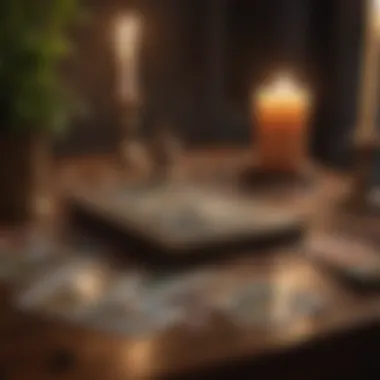

Contextual Interpretation
The context in which tarot cards are drawn plays an undeniable role in their interpretation. Understanding that a card's meaning can shift based on surrounding cards, past experiences, and current situations is essential for anyone practicing tarot.
- Position in the Spread: Each card’s position in a spread can dramatically influence its implications. For instance, the Wheel of Fortune in the future position may signify unexpected luck, whereas the same card in a past position may suggest previous cycles of prosperity that influence current situations.
- Surrounding Cards: A card may be deemed lucky due to the cards that flank it. In a reading, if you draw the Sun alongside the Fool, the cards together may convey a strong message about embracing new beginnings with a positive, carefree spirit.
- Life Circumstances: Personal life circumstances should also be taken into consideration. A card that generally denotes luck, such as the Nine of Cups, might feel discordant or hollow to someone currently facing challenges. In such cases, the interpretation should resonate more with the emotional and situational context rather than fixed meanings.
Ultimately, the act of interpreting tarot cards, particularly those associated with luck, benefits from a mindset of fluidity and openness. One must remember that luck is not received in a vacuum; it is shaped by individual choices, emotions, and circumstances.
"Luck is what happens when preparation meets opportunity." – Seneca
By intertwining intention and context, readers elevate their tarot practice. This approach can foster a richer understanding of the cards and illuminate ways to attract luck actively, rather than passively waiting for fortune to strike.
Practices to Enhance Luck through Tarot
When we talk about enhancing luck through tarot, it’s not just about a card draw here and there; it’s creating a framework where the mystical energy of the tarot intertwines with personal intent. The significance of this section lies in offering practical insights that can help individuals transform their relationship with luck, making it more palpable and effective. By engaging in specific practices, practitioners can internalize the symbolism of tarot while reinforcing their belief in their ability to attract fortune.
A successful tarot practice can effectively cultivate a mindset predisposed to recognizing and seizing opportunities, ultimately enhancing one's perceived luck. Below, we delve into significant practices – rituals and manifestation techniques – that not only deepen the connection to tarot but also bolster the sense of agency over personal fortune.
Creating a Tarot Ritual
Rituals are powerful tools in the realm of tarot. A well-crafted tarot ritual can serve as a bridge between the physical and energetic worlds. This practice involves developing a sacred space and setting a clear intention. To create such a ritual, consider these elements:
- Setting the Scene: Choose a quiet spot that feels good to you. Decorate the space with items that resonate, such as candles, crystals, or incense. This physical act creates a mental association with your tarot practice.
- Define Your Intention: Before you shuffle your deck, take a moment to reflect. Ask yourself why you’re engaging with tarot today and what you hope to achieve. Write this down; it grants clarity.
- Deck Preparation: Handle your cards with care. Some practitioners like to cleanse their decks with sage or by simply shuffling. This reinvigorates the energy of the cards.
- Card Draw Sequence: Designate a specific pattern for drawing cards. For example, a three-card spread focusing on past, present, and future can provide depth.
- Closing the Ritual: Once you’ve interpreted your cards, take a moment to express gratitude, both in spoken words and in mental acknowledgment. Consider journaling your observations and how they relate to enhancing your luck.
This ritual not only solidifies your intention but also establishes a routine that invites fortune into your life, allowing the tarot's insights to flourish.
Manifestation Techniques
Manifestation is about aligning one’s thoughts and energies with their desires and aspirations. In the context of tarot, specific techniques can amplify this alignment. Here’s how:
- Vision Boards: Use images that correspond to your tarot cards and desires. Place them where you’ll see them regularly. This visual stimulation keeps your intentions alive and buzzing.
- Affirmations: Create affirmations that reflect your intentions and tie them to specific cards. For instance, if you draw The Wheel of Fortune, affirm, "I am open to the opportunities that the universe brings to me."
- Daily Card Drawing: Make a commitment to draw a daily card with the intention of exploring its implications in your life. This simple act can provide ongoing guidance and reinforce a mindset geared toward positive change.
- Meditation: Spend time in meditation with a lucky card from your tarot deck. Visualize the energy of that card enveloping you. This practice can lead to a deeper connection with the symbolism and infuse your day with hopeful energy.
These techniques can become part of a broader practice centered around self-empowerment and awareness. As you grow in your capabilities, you'll notice that life often presents opportunities when they’re manifested with clarity and intention.
"In the landscape of tarot, luck isn’t just a chance occurrence; it’s an active pursuit of possibilities wrapped in intention.”
Harnessing these practices creates a powerful synergy between tarot and the pursuit of fortune, offering nuanced ways to understand and interact with the energies of luck.
Common Misconceptions about Lucky Tarot
When one delves into the mystical realm of tarot, a myriad of misconceptions often clouds the understanding of its relationship with luck. These misunderstandings not just distort the essence of tarot but can also lead to misguided applications in personal practices. By illuminating these common misconceptions, we can foster a better appreciation of how lucky tarot truly functions, allowing practitioners to use this tool more effectively.
Distinguishing Luck from Fate
The first quagmire many encounter is conflating luck with fate. It's easy to see how one could mistakenly think they share the same ground—after all, both concepts touch on life outcomes beyond individual control. However, luck often symbolizes chance occurrences, the unexpected windfall that alters one’s path, while fate implies a predestined course that one is bound to follow.
To clarify this further:
- Luck often appears in instances where opportunity and timing align, creating a favorable turn of events, whether it’s an unexpected job offer or finding a forgotten sum of money.
- Fate, on the other hand, suggests a path chosen before one even takes a breath—those inevitable encounters or events that steering life towards a defined destiny.
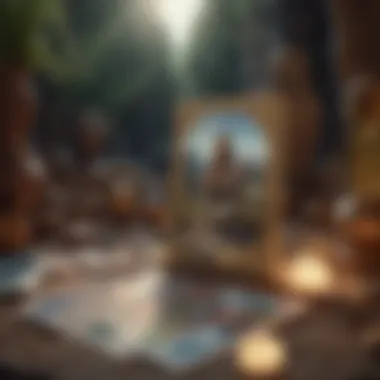

This distinction matters significantly in the tarot context. A reading focusing on lucky cards may guide one to embrace chance, informing them that fortune favors the bold rather than hinting at a predestined outcome. By recognizing the dynamic nature of luck as portrayed through tarot, practitioners can adjust their approaches, opening themselves to unexpected possibilities.
Tarot Readings and Decision Making
Another prevalent misconception is that tarot readings serve as definitive answers, dictating the course to follow. The truth is far more nuanced. Tarot offers insights and reflections, providing a backdrop against which one can make decisions but not the final word.
One should consider tarot as a helpful partner in decision-making rather than as an oracle. For instance, a spread featuring the Wheel of Fortune might highlight the potential for change, nudging the individual to seize new opportunities. Conversely, the presence of the Eight of Swords could signal feelings of entrapment, prompting the reader to explore ways to liberate themselves from self-imposed limitations.
- Effective tarot reading encourages proactive engagement, helping individuals feel more empowered.
- By applying the insights gained from a reading, one can analyze their situation and craft pathways forward rather than feeling paralyzed by predetermined outcomes.
Through elucidating these misconceptions, we shine a much-needed light on how lucky tarot can be utilized responsibly and effectively. Rather than viewing it as a tool of fate, we’re reminded that tarot serves as a vibrant compass, navigating the labyrinth of luck and choice. In doing so, we invite a more profound and responsible engagement with both the tarot and the concept of luck itself.
Case Studies and Anecdotes
In the realm of tarot, personal stories and anecdotal evidence play a vital role in bridging the gap between abstract concepts and lived experiences. Case studies bring tarot’s connection to luck into sharper focus by showcasing how individuals interact with their cards in real-life scenarios. These narratives provide insight into the diversity of interpretations, variations in practice, and the occasional serendipity that colors tarot readings.
When discussing tarot and luck, one must consider the anecdotal experiences of users. Each reading, each shuffle of the deck, can serve as a reflection of one’s mindset, circumstances, and the unpredictable nature of fortune itself. Anecdotes often highlight specific cards that have appeared during significant moments, drawing attention to the personal significance these moments hold. Understanding this element can resonate on a deeper level, transforming the tarot from mere cards into symbols rich with personal meaning.
Why Case Studies Matter
- Real-life Context: Stories offer tangible proof of how people perceive luck in their tarot experiences, providing a clearer understanding of the relationship between tarot and one's fortune.
- Relatable Experiences: Readers can find comfort in hearing the tales of others, feeling validated in their own journeys and perhaps even gathering inspiration from the struggles and successes of fellow practitioners.
- Learning Opportunities: These stories often provide unexpected lessons—moments of insight that can inspire others to adapt their tarot practices in ways that resonate more personally with them.
Through a collection of these insights, one can better understand the nuances of how tarot can influence notions of luck. This section serves as a stepping stone in realizing that luck may be as much about mindset and interpretation as it is about the physical cards drawn.
Personal Experiences with Tarot and Luck
A Journey to Understanding
One compelling case study involves a woman named Claire, who had long felt that luck had eluded her life. She turned to tarot with a skeptic’s eye, hesitant but intrigued. In one particular reading, she drew the Wheel of Fortune alongside the Ace of Wands. Initially, she was unsure—could these cards really signal a change in her fortunes?
Over the ensuing weeks, Claire focused on the messages of these two cards. She actively engaged with the notion of change and embraced new opportunities that had previously felt daunting. Strangely enough, as she aligned her actions with the interpretations of her readings, Claire found herself not only landing a new job but also experiencing unexpected financial windfalls. Her anecdote highlights the influence of tarot as a catalyst for adopting a proactive mindset geared toward recognizing and seizing opportunities.
"When I started taking the cards seriously, it felt like a light switch flipped. Luck wasn’t just random; it became something I could invite into my life." - Claire.
Collective Anecdotes
Another individual, Josh, shared an experience that intricately entwined his family’s stories with tarot readings. His grandmother had always been keen on tarot, often flipping her deck during family gatherings. One evening, she drew the King of Cups and spoke about balance and emotional wisdom—an embodiment of the supportive figures within their family.
Years later, during a difficult time, Josh revisited the deck. The King of Cups appeared to him once more. He realized that instead of seeking luck, he should turn to the wisdom of his past and the strong emotional ties that his family represented. It transformed a daunting moment into one of calm reflection. Each reading provided a unique angle on how past generations viewed luck, honor, and the heart.
Final Thoughts on Personal Stories
These personal experiences illuminate a truth: tarot can be more than a simple fortune-telling tool. It evolves into a guide that prompts self-reflection and action. The real magic lies not just in what the cards reveal but in how individuals choose to respond to their messages. Each anecdote enriches the tapestry of understanding regarding luck and tarot, encouraging an open-minded approach to one’s own readings.
Ending: The Role of Luck in Tarot
The interplay of luck and tarot transcends mere card reading; it invites an exploration into the deeper meanings of chance and serendipity. Throughout this discussion, we've seen how tarot operates not only as a guide but also as a catalyst for understanding and attracting luck into everyday life. The significance of luck in tarot can be distilled into several key elements.
First, it’s vital to recognize that luck is not a guarantee but rather a perception. Each tarot card holds the potential to unlock different narratives about our fortunes. The lucky cards—like the Wheel of Fortune—serve as reminders that life is inherently dynamic, and our circumstances can shift at any given moment. It prompts readers to remain open to the possibilities, shaping their encounters with luck.
The benefits of integrating a lucky perspective when engaging with tarot are manifold. For one, it cultivates a mindset focused on abundance. Instead of being fixated on scarcity or misfortune, tarot encourages a viewpoint where opportunities can emerge from unexpected places. This psychological shift can be pivotal. It nurtures confidence and resilience, especially in challenging circumstances. Embracing the cards as symbols of luck empowers individuals to harness their agency, thus navigating life’s twists and turns with a sense of purpose and optimism.
However, there are important considerations to keep in mind. The idea of luck can lead to an oversimplistic understanding of outcomes. Although tarot provides insights into possible futures, it is essential to balance these insights with active decision-making and personal responsibility. Relying solely on luck might mislead an individual into a passive approach to life. Harnessing luck through tarot means taking action—ensuring that one is not just waiting for the right cards to appear but is instead cultivating an environment where luck can thrive.
In essence, the role of luck in tarot coherently ties into the broader narrative of life’s unpredictability. It teaches us that while we may not control everything that comes our way, we can certainly shape our responses and perceptions. By leaning into the lessons that tarot imparts, readers not only gain insights about their current circumstances but also learn to dance with the serendipities of life. Thus, engaging with tarot becomes an active, enriching practice, steeped in the quest for understanding fortune’s whims.
